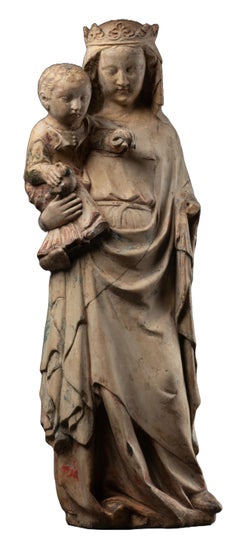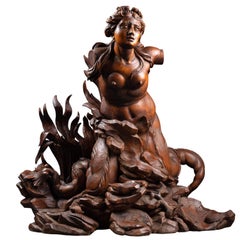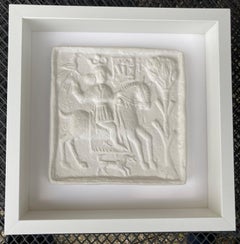Galerie Nicolas Lenté Sculptures
to
1
2
Overall Width
to
Overall Height
to
2
2
2
2
1
1
1
1
1
1
1
2
Limestone figure of Virgin and child, Lorraine, 14th century, French Gothic
Located in PARIS, FR
Virgin and Child with Goldfinch
Workshops of Metz, Lorraine, circa 1330
Limestone carved in the round with remains of polychromy
Height: 61 cm
The sculpture of the Virgin and Child ...
Category
15th Century and Earlier Gothic Figurative Sculptures
Materials
Limestone
A late 17th Italian carved limewood figure of Mermaid, circle of Filippo Parodi
Located in PARIS, FR
A late 17th c. Italian carved figure of Mermaid,
Circle of Filippo Parodi (Genoa, 1630 – July 22, 1702)
Dimensions: h. 29.13 in, w. 30.31 in, p. 18.9 in (at the base)
Magnificent Italian Baroque sculpture depicting a mermaid seated on the rock.
All the virtuosity of the sculptor unfolds in this carved group. The fantastic creature is featured seated, the upper part of the body darting forward, the head looking upwards. Sophisticated hairstyle with rows of pearls intertwined in her hair, her loose locks fly in the wind and bring movement to the whole sculpture.
The wide-open eyes with hollowed-out pupils make it possible to follow the mermaid's gaze, towards the sky. The half-open mouth further magnifies this bewitching and seductive attitude.
Its long double tail ending in fins wraps on either side of a rocky mound strewn with objects evoking the underwater world: seashells and shells, branches of coral.
The ornamental richness combined with the great care taken in its execution make it a work in which the splendor of Italian Baroque art unfolds in such characteristic scenic movement.
The composition betrays a strong influence from Filippo Parodi, the leader of Genoese Baroque sculpture, and points to an artist from his circle.
Our sculpture was probably part of a decorative monumental palace.
The iconographic theme evoking the marine world finds its application in the numerous fountains and artificial grottos, designed in Italian palaces at the turn of the 17th and 18th centuries.
Giacomo Filippo Parodi (Genoa 1630 – July 22, 1702) was an Italian Baroque sculptor of the Genoese school, who introduced Bernini's aesthetic to Genoa.
In his youth fathers a first apprenticeship with a carpenter, he went to Rome where he became a pupil of Bernini.
He had the opportunity to admire in person the works and style of the French sculptor Pierre Puget...
Category
Late 17th Century Baroque Figurative Sculptures
Materials
Wood
$21,047 Sale Price
20% Off
Related Items
Men on a Horse Medieval Tile Gypsum Cast
Located in Slovak Republic, SK
Gypsum cast-medieval tile, inspired from Central Europe. Adjusted in a frame, ready to hang or install.
Category
15th Century and Earlier Gothic Figurative Sculptures
Materials
Gesso
The Rape of Sabine Iconic Bronze Sculpture 1930
Located in Rome, IT
Fine Group of Sculptures in Bronze after Jean de Boulogne (Giambologna)
The torturously twisting Rape of the Sabine Women is one of the finest and most technically difficult sculpt...
Category
1920s Mannerist Figurative Sculptures
Materials
Bronze
$6,697 Sale Price
30% Off
H 35.44 in W 8.27 in D 8.27 in
Life Size Sculpture of Human figure on Horse: 'Golden Pegasus Armor'
By Joshua Goode
Located in New York, NY
Inspired by amateur archaeologists such as Heinrich Schliemann who discovered Troy and by past elaborate hoaxes like that of the Piltdown Man, Joshua travels the world performing sta...
Category
2010s Medieval Figurative Sculptures
Materials
Leather, Resin, Paint
$9,750
H 92 in W 92 in D 96 in
Colonial West African Baule Baoule Figure Sculpture Woman wearing loincloth
Located in Norwich, GB
An elegant African sculpture from the West African Baoulé or Baule people, depicting a young woman wearing a loincloth. Smooth black lightly worn patina.
Category
Mid-20th Century Tribal Figurative Sculptures
Materials
Wood
$760
H 17.33 in W 2.76 in D 3.55 in
Virgin and Child
Located in Wien, Wien
OUTSTANDING MADONNA
Bavaria
Around 1515/20
Lime wood carved
Original, polychrome version
Height 60 cm
This masterfully carved, full-round Madonna was created around 1515-20 in...
Category
16th Century Medieval Figurative Sculptures
Materials
Wood
A Lute Player Medieval Tile Gypsum Cast
Located in Slovak Republic, SK
Gypsum cast-medieval tile, inspired from Central Europe. Could be also adjusted in a frame, ready to hang or install ( price will be different).
Category
15th Century and Earlier Gothic Figurative Sculptures
Materials
Gesso
Medieval enthroned Virgin and Child Sedes Sapientiae acephalic granit sculpture
Located in Norwich, GB
They may be damaged and battered, but real historic objects will always give you a sense of awe. Can you sense it, looking at this ancient carved granite which depicts, as it is call...
Category
15th Century and Earlier Medieval Figurative Sculptures
Materials
Granite
$2,800
H 12.6 in W 6.11 in D 3.55 in
Large Mahogany Relief of Prometheus, The Giver of Fire in Style of Peterpaul Ott
Located in Soquel, CA
Large Scale Mahogany Wood Relief Sculpture of Prometheus, The Giver of Fire In the Style of WPA artist Peterpaul Ott
Wonderfully executed wood r...
Category
1950s Other Art Style Figurative Sculptures
Materials
Wood, Mahogany
$6,112 Sale Price
20% Off
H 50.5 in W 44 in D 2 in
Vierge romane en majesté. Bourgogne 12ème siecle.
Located in PARIS, FR
Grande vierge en majesté de l'époque romane en bois polychrome. Cette Vierge à l'enfant inédite s'inscrit dans le corpus des Vierges romanes de Bourgogne. Marie est assise sur un trô...
Category
15th Century and Earlier Medieval Figurative Sculptures
Materials
Wood
Vierge en majesté assise romane. Sedes Sapientiae.
Located in PARIS, FR
Rare Vierge romane en majesté en pierre calcaire sculptée en très haut-relief. La Vierge tient l’Enfant entre ses deux genoux dans une parfaite frontalité, une caractéristique des pr...
Category
15th Century and Earlier Medieval Figurative Sculptures
Materials
Limestone
$105,213
H 23.23 in W 8.67 in D 7.49 in
Medusa - statuesque hand carved Carrara marble and Italian linden wood sculpture
By Lorenzo Vignoli
Located in San Francisco, CA
striking hand carved Carrara marble and linden wood sculpture by contemporary Italian sculptor Lorenzo Vignoli, incorporating classical references and Greek mythology influences
Med...
Category
21st Century and Contemporary Contemporary Figurative Sculptures
Materials
Stone, Marble
$30,400
H 62.21 in W 11.82 in D 13.78 in
Vierge en majesté. Catalogne française - Maria Lactans
Located in PARIS, FR
Rare Vierge à l'Enfant en bois polychrome de tradition romane, région du Fenouillèdes, représentant une Virgo Lactans. Avant cette découverte, seules 3 vierges allaitantes médiévales...
Category
15th Century and Earlier Gothic Figurative Sculptures
Materials
Wood


